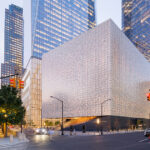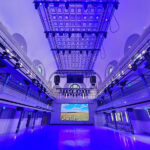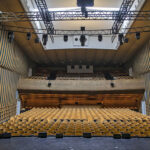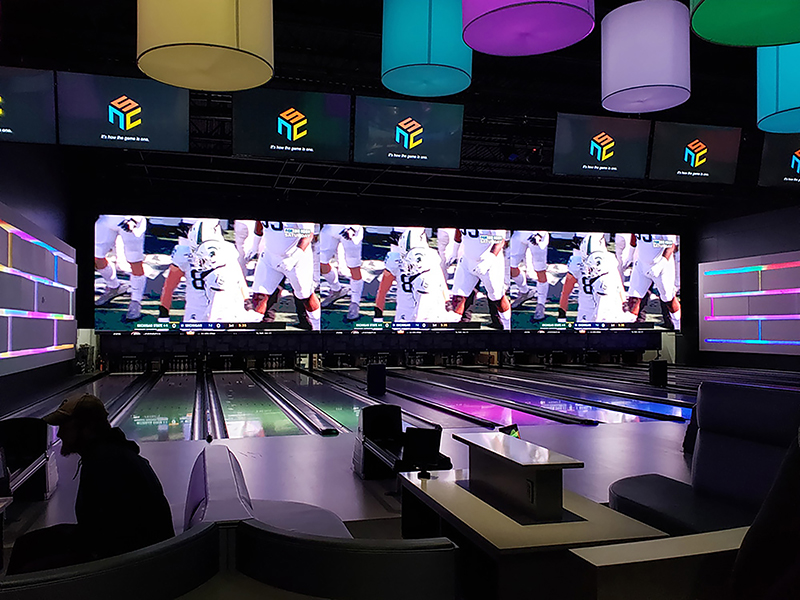
LED3 Provides Taylorleds Vapor Shine Tiles for the Spectrum Entertainment Complex in Michigan
LED3 specializes in HD display installations. Originally founded as a production company in 1999, LED3 primarily provided large screen projection for events. It evolved and emerged into an LED company as that technology became viable. A broad based market looks to them for solutions at trade events, permanent displays, concerts, scoreboards and building signage, both indoors and out. Recognized for their crystal-clear displays and custom designs, LED3 easily works in harmony with any environment, providing the best quiet, energy efficient technology setting them apart in a teeming industry.
The Ohio-based company has installations all around the country, from Washington DC to Dallas to Los Angeles. Clare Neff, the founder and partner of LED3, works with a core staff of eight, including technical project manager Brian Barry. Barry is a former production/stage manager who toured internationally for 10 years with Illusionist Franz Harary, an illusionist who incorporated large LED displays into his live shows. “Brian has a wealth of experience and in-depth knowledge,” says Neff. “That makes him ideally suited for spearheading our projects. He is our guy in the field that vets all things LED.”

The Concept
Their latest project utilized the Vapor Shine LED panel from Taylorleds for an installation within a large entertainment venue in the Grand Rapids, MI area called the Spectrum. The entertainment complex of 62,000 square feet includes a 40-lane bowling alley, a banquet room that seats 280 guests, three full bars, four full golf simulators and a stage that presents live music. A little over a year ago, the owners built an additional space designed to serve as a VIP area for corporate events — a “boutique” space with 12 premium bowling lanes.
Mike Eaton Sr., one of the owners, met the president of LED3, Bruce Neff, at a trade show and discussed the need for a large LED display at their venue. The concept was to place HD video above and across the 12 lanes for an entire background to support whatever media the corporations brought.
The display would split into three separate sections with separate feeds for each above four lanes. The display area would measure 73.8 by 13.12 feet (WxH) in size, requiring a total of 360 tiles in a 45-by-eight (WxH) configuration. Each of the three walls output 1920 x 1024 pixel resolution, totaling 5760 by 1024 pixels (WxH). The bowling lanes are the standard 53 feet in depth, so Barry selected a 3.9mm pixel pitch LED tile. “This was good enough for the distance from the foul line, and also provided true HD above each zone,” says Barry.

The Build
As new construction on the project continued for the first quarter of 2019, Barry set about vetting manufacturers for the product, returning several times to the complex to set up demos for the Eatons. He ultimately chose 3.9mm Taylorleds Vapor Shine tiles. “We came to know Taylorleds through my association with a sales rep Mike Yan, formerly of Absen, now serving as managing director of Taylorleds, and technical supervisor Evan Stevens,” states Barry. “The fact that Taylorleds’ panels are ultra-light and slim coupled with the ease of an all in one removable control and power pack, which are accessible from front or back, made this really the right product for this venue.”
By June, installation and integration were well in place by way of wiring and power. New power, consisting of a 100A 3-phase panel provided 15 individual 220v circuits to handle power loads for the screen. It was necessary to run 24 CAT 5 channels of data to handle redundancy and main data flow from processing to the video tiles. While this was all happening, concurrently the decision was made to move forward with sending Barry to the factory in China for the FAT “Factory Acceptance Test.”
“We like to do this as a matter of form to make sure nothing gets shipped to the US with any problems,” says Barry. The process at the end of the manufacturing line is that smaller sections of wall are built to look for impurities. “LED panels have masks which help with contrast, so we look to make sure the panels do not look off from angles up to 160 degrees. Pixel tests are performed to make sure RGBW is consistent. Reciprocity is measured to make sure no lagging occurs, that processing is correct, and the panels themselves are able to keep up with the processing.”
LED3 also uses NovaStar’s LED display control solutions to work with the Taylorleds tiles. Based in China, NovaStar has North America-based operations and 24/7 technical support, known for product innovation and continuous updates to their offerings. They offer products with exclusive proprietary intellectual property rights, which are now identified as industry standards.
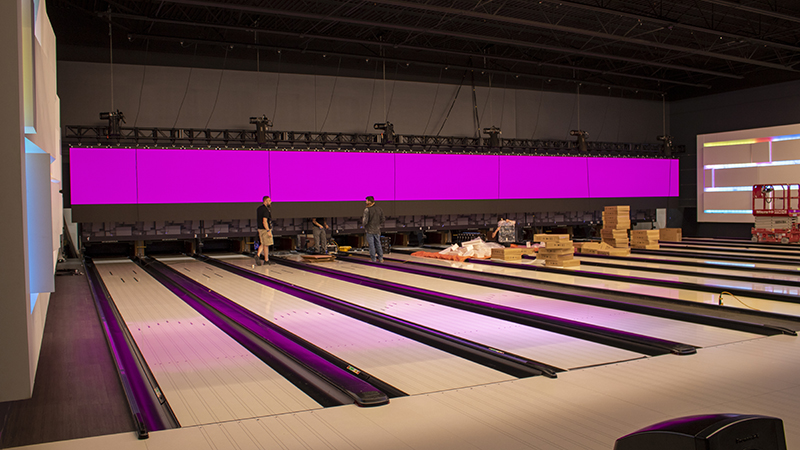
The Rigging
The owners and the construction company opted to dead hang the display after making sure the building’s steel structure could handle the additional weight along with potential snow loads. “We hung the wall on 75 feet of 12”x12” Tyler Truss,” says Barry. “We used 45 points of Taylorleds header bars connected to six-foot Liftall gakflex slings with 5/8” shackles.” It was then flown on six ½-ton CM chain hoists to facilitate the build of the wall as they added panels to its depth. In this way, the entire structure could be “swung” into place, with the truss attached to permanently welded turnbuckles. The truss, motors, and intricate rigging were provided by Dave Winkler and Steve Dumont with Corporate Live, based in Kentwood, MI.
A team of six orchestrated the installation, including LED techs Nick Jordan and Troy Prelog, warehouse manager Eric Stuhlmann, rental manager Kristen Stuhlmann, Clare Neff and Brian Barry. Mike Eaton, a Crestron Electronics dealer, opted to utilize the existing Crestron infrastructure components already in place at the Complex
“Their plan of control is for 12 Crestron NVX units to feed into three Crestron Multi-View units,” notes Barry. “These route into our NovaStar MCTRL 660 processors.” Crestron handles the scaling and routing of their various sources that are already on site.
The alley owners are brothers Mike and Ron Eaton. Mike Eaton Jr., who was the liaison between LED3 and the owners, credits LED3 as “awesome,” adding that “they helped us out with other project related referrals by bringing in Luke Lytle, who was contracted to program additional LED lighting on the walls and around the bar. I would highly recommend them to anyone.”
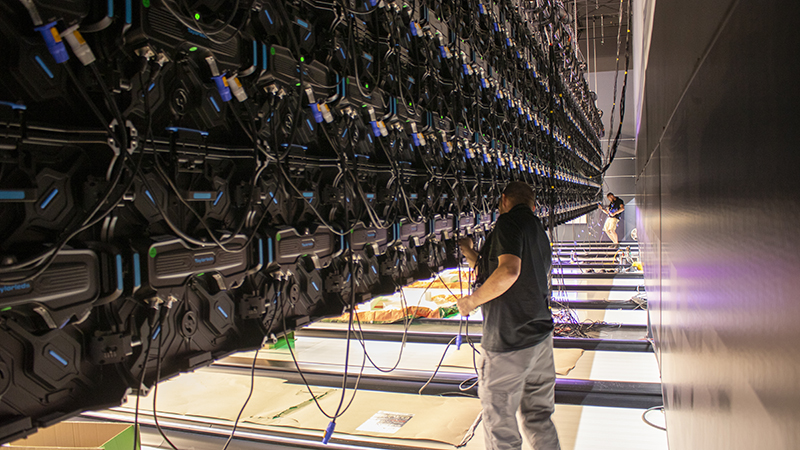
Up Next
“We are burgeoning into a vertical market of trade and exhibit show providers and builders,” says Barry. “To that end, our focus has somewhat shifted. As the trade show market has developed into a more digital environment, LED displays extend the opportunity to show product launches, PowerPoint presentations, and interactive content, providing the clients with greater ROI in the confined footprint of the booth space. The “content” can change many times throughout the day as opposed to the same static image. SCG and Sintra display applications can still be incorporated with the LED display for additional options.
“We work extensively with exhibit builders,” Barry continues, “to integrate affordable LED display options into their already existing structures with only minimal modifications instead of buying proprietary products. It gives clients a cost effective value alternative.” Adds Clare, as a further assurance of their company’s integrity, expertise and commitment, “We offer extended warranties and repairs on anything we sell.”

For more information, visit www.led3showroom.com and www.taylorleds.com.
